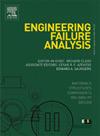Study on hysteresis behavior of two kinds of reinforced CHS X-joints
IF 4.4
2区 工程技术
Q1 ENGINEERING, MECHANICAL
引用次数: 0
Abstract
Ultra-low cycle fatigue loading tests were conducted on two reinforced CHS X-joints (external stiffening rings and plates) and an unreinforced joint to analyze their post-yield failure modes, fracture mechanisms, and hysteretic properties. The findings indicate that these three joints exhibit varying failure modes post-yield: the unreinforced joints fail primarily due to chord fracture at the weld; the ring-reinforced joints initially see ring fracture, followed by chord crack at the weld; while the plate-reinforced joints initially fail from chord fracture and subsequently develop cracks at the plate-chord interface. The reinforced joints display plumper hysteretic loops and higher ultimate bearing capacities than the unreinforced joint. Compared to X-1, the tensile and compressive ultimate bearing capacities of RX-1 have increased significantly by 56.9 % and 74.1 %, respectively. In comparison, those of TX-1 have increased moderately by 2.2 % and 67.6 %, respectively, albeit with a slight compromise in ductility. The cumulative energy dissipation of RX-1 and TX-1 has risen by 22.62 % and 131.99 %, respectively, compared to the unreinforced joint. Notably, the dissipated energy before cracking accounts for 16.50 %, 18.16 %, and 22.29 % of the cumulative energy dissipation for the three joints, respectively, highlighting the substantial contribution of crack propagation to energy dissipation under large deformations. The VUSDFLD subroutine based on Cyclic Void Growth Model (CVGM) is embedded into ABAQUS, this subroutine considers the initiation and propagation of joint cracks. Three finite element models with the same dimensions of the specimens were built to simulate the damage process of the joint. The results show that this method can accurately simulate such joints’ cracking and crack growth behavior under cyclic axial load. The simulated hysteresis curve is in good agreement with the test curve.
两种增强型 CHS X 形接头的滞后行为研究
对两个加固 CHS X 接头(外部加固环和板)和一个未加固接头进行了超低循环疲劳加载试验,以分析其屈服后失效模式、断裂机制和滞后特性。研究结果表明,这三种接头在屈服后表现出不同的失效模式:未加固接头主要由于焊缝处的弦断裂而失效;环形加固接头最初出现环形断裂,随后在焊缝处出现弦裂纹;而板加固接头最初由于弦断裂而失效,随后在板-弦界面处出现裂纹。与未加固的接头相比,加固接头显示出更丰满的滞后环和更高的极限承载能力。与 X-1 相比,RX-1 的拉伸和压缩极限承载力分别显著提高了 56.9% 和 74.1%。相比之下,TX-1 的极限承载能力分别提高了 2.2% 和 67.6%,但延展性略有下降。与未加固接头相比,RX-1 和 TX-1 的累积耗能分别增加了 22.62% 和 131.99%。值得注意的是,开裂前的耗散能量分别占三个接头累积耗散能量的 16.50 %、18.16 % 和 22.29 %,这突出表明了在大变形情况下裂纹扩展对能量耗散的巨大贡献。ABAQUS 中嵌入了基于循环虚空生长模型(CVGM)的 VUSDFLD 子程序,该子程序考虑了接头裂纹的产生和扩展。建立了三个与试样尺寸相同的有限元模型来模拟接头的损坏过程。结果表明,该方法可以准确模拟此类接头在循环轴向载荷作用下的开裂和裂纹生长行为。模拟的滞后曲线与测试曲线非常吻合。
本文章由计算机程序翻译,如有差异,请以英文原文为准。
求助全文
约1分钟内获得全文
求助全文
来源期刊

Engineering Failure Analysis
工程技术-材料科学:表征与测试
CiteScore
7.70
自引率
20.00%
发文量
956
审稿时长
47 days
期刊介绍:
Engineering Failure Analysis publishes research papers describing the analysis of engineering failures and related studies.
Papers relating to the structure, properties and behaviour of engineering materials are encouraged, particularly those which also involve the detailed application of materials parameters to problems in engineering structures, components and design. In addition to the area of materials engineering, the interacting fields of mechanical, manufacturing, aeronautical, civil, chemical, corrosion and design engineering are considered relevant. Activity should be directed at analysing engineering failures and carrying out research to help reduce the incidences of failures and to extend the operating horizons of engineering materials.
Emphasis is placed on the mechanical properties of materials and their behaviour when influenced by structure, process and environment. Metallic, polymeric, ceramic and natural materials are all included and the application of these materials to real engineering situations should be emphasised. The use of a case-study based approach is also encouraged.
Engineering Failure Analysis provides essential reference material and critical feedback into the design process thereby contributing to the prevention of engineering failures in the future. All submissions will be subject to peer review from leading experts in the field.
 求助内容:
求助内容: 应助结果提醒方式:
应助结果提醒方式:


